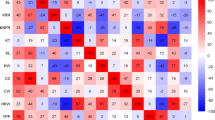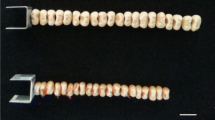Abstract
Genetic factors controlling quantitative inheritance of grain yield and its components have been intensively investigated during recent decades using diverse populations in maize (Zea mays L.). Notwithstanding this, quantitative trait loci (QTL) for kernel row number (KRN) with large and consistent effect have not been identified. In this study, a linkage map of 150 simple sequence repeat (SSR) loci was constructed by using a population of 500 F2 individuals derived from a cross between elite inbreds Ye478 and Dan340. The linkage map spanned a total of 1478 cM with an average interval of 10.0 cM. A total of 397 F2:3 lines were evaluated across seven diverse environments for mapping QTL for KRN. Some QTL for grain yield and its components had previously been confirmed with this population across environments. A total of 13 QTL for KRN were identified, with each QTL explaining from 3.0 to 17.9% of phenotypic variance. The gene action for KRN was mainly additive to partial dominance. A large-effect QTL (qkrn7) with partial dominance effect accounting for 17.9% of the phenotypic variation for KRN was identified on chromosome 7 near marker umc1865 with consistent gene effect across seven diverse environments. This study has laid a foundation for map-based cloning of this major QTL and for developing molecular markers for marker-assisted selection of high KRN.


Similar content being viewed by others
Abbreviations
- A:
-
Additive
- CD:
-
Cob diameter
- CI:
-
Confidence interval
- CIM:
-
Composite interval mapping method
- cM:
-
CentiMorgan
- CV:
-
Coefficient of variation
- D:
-
Dominance
- d/a:
-
Dominance effects/additive effects
- ED:
-
Ear diameter
- EL:
-
Ear length
- GY:
-
Grain yield
- IM:
-
Interval mapping
- KNE:
-
Kernel number per ear
- KNR:
-
Kernel number per row
- KRN:
-
Kernel row number
- KW:
-
100-kernel weight
- LOD:
-
Logarithm of odds
- OD:
-
Overdominance
- PCR:
-
Polymerase chain reaction
- PD:
-
Partial dominance
- QTL:
-
Quantitative trait locus
- SSR:
-
Simple sequence repeat
References
Alber BSB, Edwards MD, Stuber CW (1991) Isoenzymatic identification of quantitative trait loci in crosses of elite maize inbreds. Crop Sci 31:267–274
Allison DB, Fernandez JR, Heo M, Zhu S, Etzel C, Beasley TM, Amos CI (2002) Bias in estimates of quantitative-trait-locus effect in genome scans: demonstration of the phenomenon and a method-of-moments procedure for reducing bias. Am J Hum Genet 70:575–585
Austin DF, Lee M (1996) Comparative mapping in F2:3 and F6:7 generation of quantitative trait loci for grain yield and yield components in maize. Theor Appl Genet 92(7):817–826
Austin DF, Lee M (1998) Detection of quantitative trait loci for grain yield and yield components in maize across generations in stress and nonstress environments. Crop Sci 38(5):1296–1308
Beavis WD (1994a) The power and deceit of QTL experiments: lesson from comparative QTL studies. In: Wilkinson DB (ed), Proc. 49th Annu. Corn and Sorghum Res. Conf. ASTA, Washington, pp 250–266
Beavis WD (1998) QTL analyses: power, precision, and accuracy. In: Paterson AH (ed) Molecular dissection of complex traits. CRC Press, New York, pp 145–162
Beavis WD, Smith OS, Grant D, Fincher R (1994) Identification of quantitative trait loci using a small sample of topcrossed and F4 progeny from maize. Crop Sci 34:882–896
Charcosset A, Gallais A (1996) Estimation of the contribution of quantitative trait loci (QTL) to the variance of a quantitative trait by means of genetic markers. Theor Appl Genet 93:1193–1201
Churchill GA, Doerge RW (1994) Empirical threshold values for quantitative trait mapping. Genetics 138(3):963–971
CIMMYT Applied Molecular Genetics Laboratory (2001) Laboratory protocols CIMMYT, Mexico DF, Mexico
Dhillon BS, Singh J (1977) Estimation and inheritance of stability parameters of grain yield in maize. J Agric Sci 88:257–265
Goldman IL, Rocheford TR, Dudley JW (1994) Molecular markers associated with maize kernel oil concentration in an Illinois high protein × Illinois low protein cross. Crop Sci 34(4):908–915
Göring HHH, Terwilliger JD, Blangero J (2001) Large upward bias in estimation of locus-specific effects from genomewide scans. Am J Hum Genet 69:1357–1369
Hallauer AR, Miranda JB (1988) Quantitative genetics in maize breeding. Iowa State University Press, Ames, p 90
Knapp SJ, Stroup WW, Ross WM (1985) Exact confidence intervals for heritability on a progeny mean basis. Crop Sci 25:192–194
Knapp SJ, Bridges WC, Birkes D (1990) Mapping quantitative trait loci using molecular maker linkage maps. Theor Appl Genet 79:583–592
Kosambi DD (1944) The estimation of map distances from recombination values. Ann Eugen 12:172–175
Lander ES, Green P, Abrahamson J, Barlow A, Daly MJ, Lincoln SE, Newburg L (1987) MapMaker: an interactive computer package for constructing primary genetic linkage maps of experimental and natural populations. Genomics 1:174–181
Lima MLA, Souza CL Jr, Bento DAV, Souza AP, Carlini-Garcia LA (2006) Mapping QTL for grain yield and plant traits in a tropical maize population. Mol Breed 17:227–239
Lincoln SE, Daly MJ, Lander ES (1992) Constructing genetic maps with MAPMAKER/EXP version 3.0, 3rd edn. Whitehead Technical Report
Lu H, Romero-Severson J, Bernardo R (2003) Genetic basis of heterosis explored by simple sequence repeat markers in a random-mated maize population. Theor Appl Genet 107(3):494–502
Ma XQ, Tang JH, Teng WT, Yan JB, Meng YJ, Li JS (2007) Epistatic interaction is an important genetic basis of grain yield and its components in maize. Mol Breed 20(1):41–51
Melchinger AE, Utz HF, Schön CC (1998) Quantitative trait locus (QTL) mapping using different testers and independent population samples in maize reveals low power of QTL detection and large bias in estimates of QTL effects. Genetics 149:383–403
Moll RH, Lindsey MF, Robinson HF (1964) Estimates of genetic variances and level of dominance in maize. Genetics 49:411–423
Sabadin PK, de Souza CL Jr, de Souza AP, Garcia AAF (2008) QTL mapping for yield components in a tropical maize population using microsatellite markers. Hereditas 145(4):194–203
Saghai-Maroof MA, Soliman KM, Jorgensen RA, Allard RW (1984) Ribosomal DNA spacer-length polymorphisms I barley: Mendelian inheritance, chromosomal locations, and population dynamics. Proc Natl Acad Sci USA 81:8014–8018
Salvi S, Tuberosa R (2007) Cloning QTLs in plants. In: Varshney RK, Tuberosa R (eds) Genomics-assisted crop improvement, Vol. 1: genomics approaches and platforms. Springer, New York, pp 207–226
SAS Institute (2003) SAS proprietary software release 9.1. SAS Institute Inc, Cary
Schön CC, Utz HF, Groh S, Truberg B, Openshaw S, Melchinger AE (2004) QTL mapping based on resampling a vast maize testcross experiment and its relevance to quantitative genetics to complex traits. Genetics 167:485–498
Stuber CW, Edwards MD, Wendel JF (1987) Molecular marker-facilitated investigations of quantitative trait loci in maize. II. Factors influencing yield and its component traits. Crop Sci 27(3):639–648
Stuber CW, Lincoln Sf, Wolff DW (1992) Identification of genetic factors contributing to heterosis in a hybrid from two elite maize inbred lines using molecular markers. Genetics 132(3):823–839
Tuberosa R, Salvi S (2009) QTL for agronomic traits in maize. In: Bennetzen J, Hake S (eds) The maize handbook. Springer, New York, pp 501–542
Utz HF, Melchinger AE, Schön CC (2000) Bias and sampling error of the estimated proportion of genotypic variance explained by quantitative trait loci determined from experimental data in maize using cross validation and validation with independent samples. Genetics 154:1839–1849
Veldboom LR, Lee M (1994) Molecular-marker-facilitated studies of morphological traits in maize II Determination of QTLs for grain yield and yield components. Theor Appl Genet 89:451–458
Veldboom LR, Lee M (1996) Genetic mapping of quantitative trait loci in maize in stress and nonstress Environments: I. Grain yield and yield components. Crop Sci 36:1310–1319
Veldboom LR, Lee M, Woodman WL (1994) Molecular marker-facilitated studies in an elite maize population: I. Linkage analysis and determination of QTL for morphological traits. Theor Appl Genet 88(1):7–16
Wang S, Basten CJ, Zeng ZB (2006) Windows QTL cartographer 2.5. Department of Statistics, North Caroline State University, NC (http://statgen.ncsu.edu/qtlcart/WQTLcart.htm)
Xiang DQ, Cao HH, Cao YG, Yang JP, Huang LJ, Wang SC, Dai JR (2001) Construction of a genetic map and location of quantitative trait loci for yield component traits in maize by SSR marker. Acta Genet Sin 28(8):778–784 (in Chinese)
Xie CX, Warburton M, Li MS, Li XH, Xiao MJ, Hao ZF, Zhao Q, Zhang SH (2008) An analysis of population structure and linkage disequilibrium using multilocus data in 187 maize inbred lines. Mol Breed 21(4):407–418
Yan JB, Tang H, Huang YQ, Zheng YL, Li JS (2006) Quantitative trait loci mapping and epistatic analysis for grain yield and yield components using molecular markers with an elite maize hybrid. Euphytica 149:121–131
Yang JP, Rong TZ, Xiang DQ, Tang HT, Huang LJ, Dai JR (2005) QTL mapping of quantitative traits in maize. Acta Agronom Sin 2:188–196 (in Chinese)
Acknowledgments
This research was supported by “973” program (2009CB118400-04) from the China Ministry of Science and Technology and a Program (30871535) from the National Science Foundation of China. We are thankful to Dr. Yunbi Xu from the International Maize and Wheat Improvement Center (CIMMYT) for suggestions and revisions to this manuscript.
Author information
Authors and Affiliations
Corresponding authors
Electronic supplementary material
Below is the link to the electronic supplementary material.
Supplementary Fig. 1
The ears of inbred Ye478, Dan340 and their F1. (PDF 28 kb)
Rights and permissions
About this article
Cite this article
Lu, M., Xie, CX., Li, XH. et al. Mapping of quantitative trait loci for kernel row number in maize across seven environments. Mol Breeding 28, 143–152 (2011). https://doi.org/10.1007/s11032-010-9468-3
Received:
Accepted:
Published:
Issue Date:
DOI: https://doi.org/10.1007/s11032-010-9468-3




